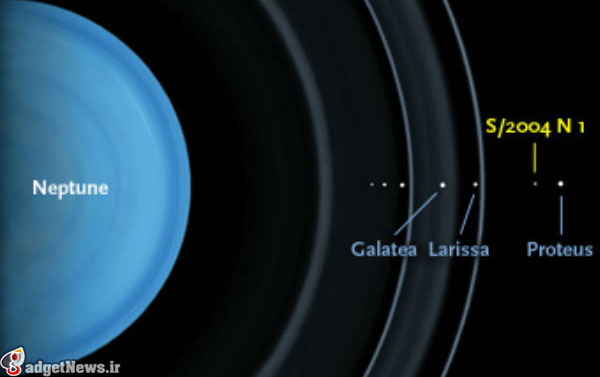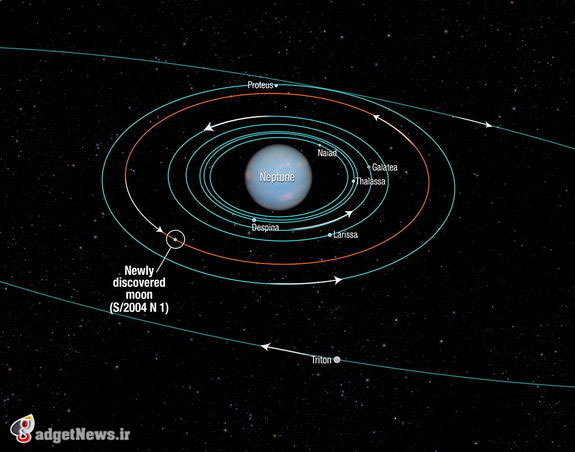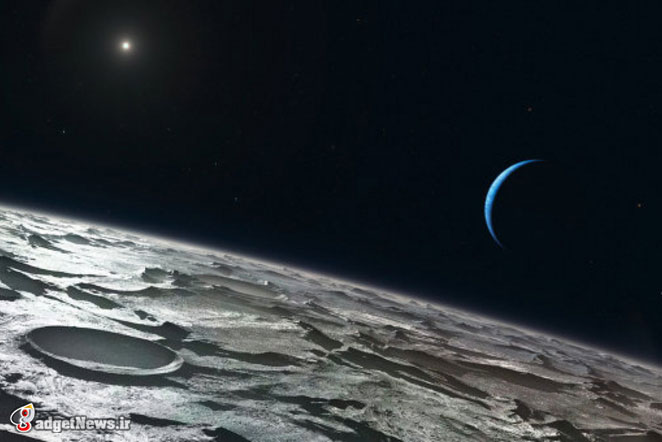
اخترشناسان با استفاده از تلسکوپ فضایی «هابل» موفق به کشف قمر جدیدی در اطراف سیاره نپتون شدند.«مارک شاولتر» از محققان موسسه SETI در کالیفرنیا در تاریخ اول جولای (10 تیر) در هنگام بررسی کمان کم نور یا بخشی از حلقه های اطراف نپتون موفق به شناسایی این قمر جدید شد.
این اخترشناس حرکت یک نقطه سفید در بیش از 150 عکس آرشیوی تهیه شده توسط تلسکوپ فضایی هابل طی سال های 2004 تا 2009 میلادی را رهگیری و قمر S/2004N1 را شناسایی کرد که کوچکترین قمر شناخته شده در سیستم نپتون محسوب می شود.

«شاولتر» تأکید می کند: قمرها و حلقه ها با سرعت در مدار اطراف نپتون در حال چرخش هستند و همانطور که یک عکاس ورزشی حرکات دونده ای را در حین مسابقه تعقیب می کند، باید مسیر حرکات اجرام مختلف در اطراف سیستم نپتون را به دقت بررسی کرد.

این قمر کوچک و کم نور حدود 100 میلیون برابر کم نورتر از کم نورترین ستاره ای است که با چشم غیر مسلح قابل مشاهده است و حتی فضاپیمای «وویجر 2» ناسا که سیستم قمرهای این سیاره و حلقه های ان را در سال 1989 میلادی بررسی کرده بود، موفق به شناسایی این قمر کوچک نشده بود.

قمر S/2004N1 بین مدار قمرهای لاریسا و پروتئوس واقع شده و گردش کامل آن به دور نپتون 23 ساعت به طول می انجامد.با کشف این قمر جدید، تعداد اجرام در مدار سیاره نپتون به 14 عدد افزایش یافت.
منبع : space
Tiny New Moon Discovered Around Neptune
The Hubble Space Telescope has revealed a small, never-before-seen moon around Neptune, boosting the giant blue planet's total satellite count to 14 satellites, new photos reveal.
The newfound Neptune moon — called S/2004 N 1 — was discovered July 1 during a fresh analysis of older Hubble Space Telescope images, scientists said. The newly discovered satellite is Neptune's smallest known moon and is just 12 miles (19 kilometers) wide.
Hubble telescope scientists announced the new Neptune moon's discovery today (July 15). The small satellite wasn't easy to find
– See more at: http://www.space.com/21967-tiny-neptune-moon-discovered-hubble-photos.html#sthash.GZs0FM7M.dpuf
The moons and arcs [segments of rings around the planet] orbit very quickly, so we had to devise a way to follow their motion in order to bring out the details of the system," SETI Institute scientist Mark Showalter, the moon's discoverer, said in a statement. "It's the same reason a sports photographer tracks a running athlete — the athlete stays in focus, but the background blurs."
In order to find the moon, Showalter dug through archival photos taken by Hubble from 2004 to 2009. The newly found moon appears in about 150 of those photos. By plotting a circular orbit of the moon, Showalter saw that the tiny satellite fully orbits Neptune every 23 hours.
The tiny moon is so small and hard to see that it even evaded NASA's Voyager 2 spacecraft when it flew by Neptune in 1989. At the time, Voyager 2 revealed six previously unknown moons in orbit around the blue planet, NASA officials have said.
At 1,680 miles (2,700 km) across, Neptune's biggest moon is Triton. It is the only large moon in the solar system that has a retrograde orbit, meaning that it orbits in the opposite direction of its host planet's rotation, scientists have found.
Because of this strange orbit, some experts suspect that Triton is a dwarf planet caught in Neptune's gravitational pull.
"This capture would have gravitationally torn up any original satellite system Neptune possessed," Hubble officials wrote in a statement. "Many of the moons now seen orbiting the planet probably formed after Triton settled into its unusual retrograde orbit about Neptune."
 گجت نیوز آخرین اخبار تکنولوژی، علم و خودرو
گجت نیوز آخرین اخبار تکنولوژی، علم و خودرو 





